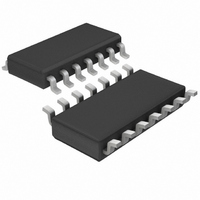LT1251CS Linear Technology, LT1251CS Datasheet - Page 14

LT1251CS
Manufacturer Part Number
LT1251CS
Description
IC AMP VIDEO FADE CONTRLD 14SOIC
Manufacturer
Linear Technology
Datasheet
1.LT1256CSPBF.pdf
(24 pages)
Specifications of LT1251CS
Applications
Current Feedback
Number Of Circuits
1
-3db Bandwidth
40MHz
Slew Rate
300 V/µs
Current - Supply
14.5mA
Current - Output / Channel
40mA
Voltage - Supply, Single/dual (±)
5 V ~ 30 V, ±2.5 V ~ 15 V
Mounting Type
Surface Mount
Package / Case
14-SOIC (0.154", 3.90mm Width)
Lead Free Status / RoHS Status
Contains lead / RoHS non-compliant
Available stocks
Company
Part Number
Manufacturer
Quantity
Price
Part Number:
LT1251CS
Manufacturer:
LT/凌特
Quantity:
20 000
Part Number:
LT1251CS#PBF
Manufacturer:
LINEAR/凌特
Quantity:
20 000
Part Number:
LT1251CS#TRPBF
Manufacturer:
LINEAR/凌特
Quantity:
20 000
LT1251/LT1256
APPLICATIONS
Control Circuit Description
The control section of the LT1251/LT1256 consists of two
identical voltage-to-current converters (V-to-I); each
V-to-I contains an op amp, an NPN transistor and a
resistor. The converter on the right generates a full-scale
current I
current I
minimum of zero (when I
(when I
gain from each signal input to the output.
The op amp in each V-to-I drives the transistor until the
voltage at the inverting input is the same as the voltage at
the noninverting input. If the open end of the resistor (Pin
5 or 10) is grounded, the voltage across the resistor is the
same as the voltage at the noninverting input. The emitter
current is therefore equal to the input voltage V
the resistor value R
the same as the emitter current and it is the ratio of the two
collector currents that sets the gain.
The LT1251/LT1256 are tested with Pins 5 and 10 grounded
and a full-scale voltage of 2.5V applied to V
sets I
applied to Pin 3. When the control voltage is negative or
zero, I
I
channel one goes from 0% to 100% as V
to 2.5V. The gain of channel two goes the opposite way,
from 100% down to 0%. The worst-case error in K (the
14
R
V
V
C
I
C
C
C
+
is equal to or greater than I
3
4
5
FS
C
C
at approximately 500 A; the control voltage V
is zero and K is zero. When V
CONTROL V TO I
FS
C
is equal to, or greater than, I
+
–
. The ratio I
Figure 3. Control Circuit Block Diagram
and the one on the left generates a control
C
R
5k
C
U
C
. The collector current is essentially
I
C
C
/I
INFORMATION
FS
C
U
is zero) to a maximum of one
is called K. K goes from a
FS
and K is one. The gain of
I
FS
W
FS
C
FULL SCALE V TO I
). K determines the
is 2.5V or greater,
C
R
FS
5k
FS
goes from zero
FS
(Pin 12). This
+
–
C
divided by
U
10
11
12
1251/56 F03
C
V
I
R
FS
FS
FS
is
gain) is 3% as detailed in the electrical tables. By using
a 2.5V full-scale voltage and the internal resistors, no
additional errors need be accounted for.
In the LT1256, K changes linearly with I
is zero, V
the worst-case control op amp offset. Similarly to insure
that K is 100%, V
the guaranteed gain accuracy.
To eliminate the overdrive requirement, the LT1251 has
internal circuitry that senses when the control current is at
about 5% and sets K to 0%. Similarly, at about 95% it sets
K to 100%. The LT1251 guarantees that a 2% (50mV)
input gives zero and 98% (2.45V) gives 100%.
The operating currents of the LT1251/LT1256 are derived
from I
of V
current for three values of V
mate formula for the supply current is:
where V
By reducing I
ever, the slew rate and bandwidth will also be reduced as
indicated in the characteristic curves. Using the internal
resistors (5k) with V
500 A; there is no reason to use a larger value of I
The inverting inputs of the V-to-I converters are available
so that external resistors can be used instead of the
internal ones. For example, if a 10V full-scale voltage is
desired, an external pair of 20k resistors should be used to
set I
greater than the maximum V
transistors from saturating. Do not use the internal resis-
tors with external resistors because the internal resistors
have a large positive temperature coefficient (0.2%/ C)
that will cause gain errors.
If the control voltage is applied to the free end of resistor
R
of the control voltage must be inverted. Therefore, K will
be 0% for zero input and 100% for – 2.5V input, assuming
V
ground; this is convenient for summing several negative
going control signals.
C
FS
I
(Pin 5) and the V
S
FS
equals 2.5V. With Pin 3 grounded, Pin 4 is a virtual
FS
= 1mA + (24)(I
FS
to 500 A. The positive supply voltage must be 2.5V
and R
S
and therefore the quiescent current is a function
C
is the total supply voltage between Pins 9 and 7.
must be negative 15mV or more to overcome
FS
FS
. The electrical tables show the supply
the supply current can be reduced, how-
C
C
must be 3% larger than V
FS
FS
input (Pin 3) is grounded, the polarity
) + (V
equal to 2.5V results in I
FS
S
/20k)
including zero. An approxi-
C
and/or V
C
. To insure that K
FS
to keep the
FS
FS
based on
equal to
FS
.













